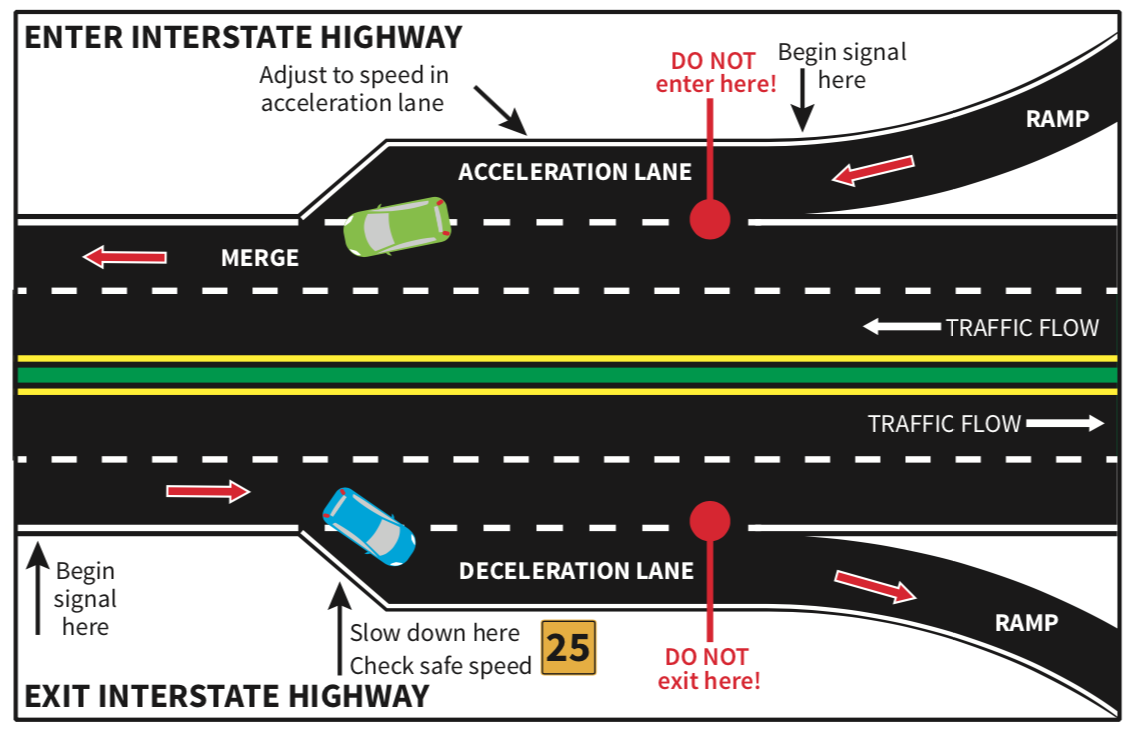Signalling and Merging
The Vehicle Code does require you to use your turn signal whenever you make a right or left turning movement if you are in close proximity to another vehicle and that movement would affect that other vehicle. When you are changing lanes or using your turn signal, the Vehicle Code also requires you to have your turn signal activated for a minimum of 100 feet, prior to making that turning movement, The best rule of thumb is to always use your turn signal if you’re going make a right or left turn movement while driving on the highway.
What Does a Merge Sign Mean?
The merge sign is a regulatory sign. Drivers who encounter a merge sign are warned that two separate roadways will converge into one lane ahead. The merging traffic sign will typically indicate which lane should be merging into the other. Drivers on the main highway should be aware of merging vehicles. Merging vehicles must yield to traffic on the main highway.
- Merge signs indicate the drivers should be prepared to merge with vehicles on a separate road.
- The merging traffic sign will use an arrow to show which roadway is merging.
- The vehicles on the bigger roadway have the right of way but should be considerate of merging vehicles.
Who gets the right of way when merging onto the highway?
Entering a highway from an on ramp can be a stressful situation, especially for new drivers. Most states give the right of way to the vehicle that is traveling on the highway. The vehicle entering must yield to those vehicles, but there are a few states that indicate both drivers must attempt to adjust their speed and location to avoid a collision. You should review your state’s rules of the road for what your state requires.
I would like to share a few pointers that will work in all states. Upon entering the on ramp, a driver needs to attempt to get up to speed to safely merge onto the highway. While getting up to speed, the driver should activate their turn signal so the interstate traffic can see your intentions. This may allow a driver on the highway time to switch lanes to allow you on the highway.
While on the ramp, a driver should also be looking for a spot in traffic to merge into. They should be looking into their mirrors to see if there’s a gap between vehicles to fit into in the near lane. You should avoid making an abrupt merge to avoid causing a crash. A driver should also avoid stopping on the ramp because of the difficulty to get back up to highway speed. Once on the highway, you should adjust your speed to create a safe gap between other vehicles and ensure a safe trip.
Changing Lanes: What To Do
Step #1: Turn on your turn signal.
Turn signals are the only way you can let other drivers know that you’ll be changing lanes. Traffic School Online reports that you are legally required to activate your turn signals at least 100 feet before making your move. Using your blinker to signal your intent to change lanes, merge into traffic, and even turn into a parking spot can help keep you safe and ticket-free. Plus, when you’re in a traffic jam, using your turn signal may be the only way to “ask” another driver to let you in ahead of them.
Step #2: Check your rearview and side mirrors.
After activating your blinker, take a look into your rearview and side mirror to ensure you have enough space to make the lane change. If there’s a car in the lane you’re merging into, wait until you can see the entire vehicle (wheels included) and a few feet of pavement in front of it in your rearview mirror.
At this point, if the other car is going at or below the same speed as you are, you should have enough room to change lanes. It’s essential to keep an eye on the speed of the car you’re trying to merge ahead of — if they’re accelerating, you are better off letting them pass you before changing lanes (as the space for your car is quickly closing).
While some states allow drivers to speed when passing slow vehicles, doing so isn’t always in your best interest. Speeding is one of the fastest ways to increase your risk of an accident.
Step #3: Look over your shoulder to check your blind spot.
Even after checking your mirrors, there’s a spot behind the car that you can’t see – and that spot could easily contain a car or motorcycle! Immediately after checking your mirrors, look over your right shoulder to ensure you don’t miss anything. Always remember when checking your mirrors and blind spot that it’s easy to miss smaller objects, like cyclists, so keep your eyes peeled. Additionally, you can better avoid getting hit by not lingering in other drivers’ blind spots.
Step #4: Change lanes!
Once you’ve determined that it is safe to change lanes, it’s time to go for it! Maintain your speed and glide into the lane smoothly.
Step #5: Turn your turn signal off.
Don’t be that person driving down the highway with your turn signal blinking. As soon as you’re in your desired lane, turn off your blinker.


¿Qué significa un signo de merge?
La señal de merge es una señal reglamentaria. Se advierte a los conductores que se encuentren con una señal de fusión que dos caminos separados convergerán en un carril más adelante. La señal de tráfico de fusión generalmente indicará qué carril debe fusionarse con el otro. Los conductores en la carretera principal deben estar atentos a los vehículos que se incorporan. Los vehículos que se incorporen deben ceder el paso al tráfico en la carretera principal.
- Merge signs indicate the drivers should be prepared to merge with vehicles on a separate road.
- Merge las señales indican que los conductores deben estar preparados para incorporarse a los vehículos en una carretera separada.
- La señal de tráfico que se fusiona utilizará una flecha para mostrar qué carretera se está fusionando.
- Los vehículos en la calzada más grande tienen el derecho de paso, pero deben tener cuidado con los vehículos que se fusionan.
¿Quién tiene el derecho de paso al incorporarse a la autopista?
Entrar a una autopista desde una rampa puede ser una situación estresante, especialmente para los conductores nuevos. La mayoría de los estados dan el derecho de paso al vehículo que circula por la carretera. El vehículo que ingresa debe ceder el paso a esos vehículos, pero hay algunos estados que indican que ambos conductores deben intentar ajustar su velocidad y ubicación para evitar una colisión. Debe revisar las reglas de tránsito de su estado para conocer los requisitos de su estado.
Me gustaría compartir algunos consejos que funcionarán en todos los estados. Al ingresar a la rampa de entrada, el conductor debe intentar acelerar para incorporarse de manera segura a la carretera. Mientras acelera, el conductor debe activar su señal de giro para que el tráfico interestatal pueda ver sus intenciones. Esto puede permitir que un conductor en la carretera cambie de carril para permitirle a usted en la carretera.
Mientras está en la rampa, un conductor también debe buscar un lugar en el tráfico para incorporarse. Deben estar mirando en sus espejos para ver si hay un espacio entre los vehículos para encajar en el carril cercano. Debe evitar hacer una fusión abrupta para evitar causar un bloqueo. Un conductor también debe evitar detenerse en la rampa debido a la dificultad de volver a la velocidad de la autopista. Una vez en la carretera, debe ajustar su velocidad para crear un espacio seguro entre otros vehículos y garantizar un viaje seguro.
